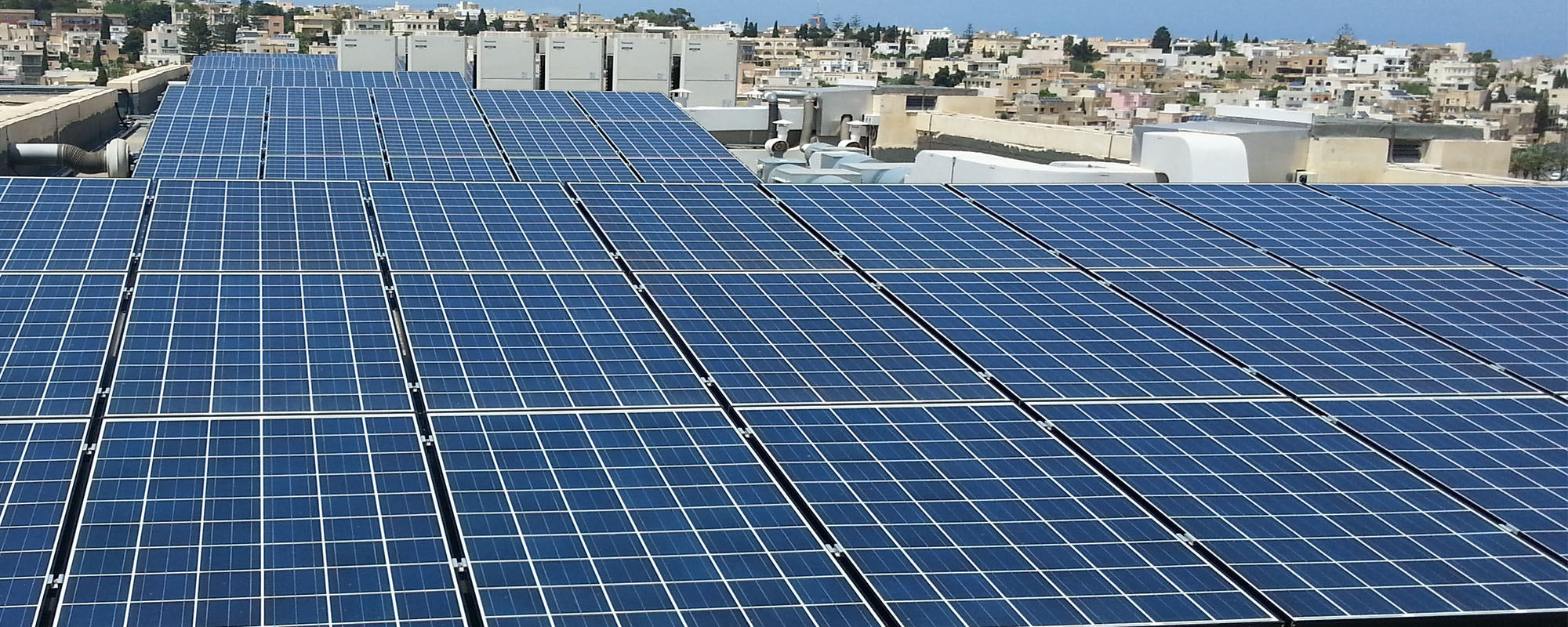Can the university lead the way in shedding a dependence on fossil fuels? Renewable sources cover just over 7% of Malta’s energy needs, which must nearly double by 2030 to implement the draft National Energy and Climate Plan. Daiva Repeckaite traces how photovoltaic modules were rolled out on the campus’s roofs — and finds that to be sustainable, the community should love their ACs a little less.
On a satellite view of the University of Malta’s (UM) Tal-Qroqq campus on Google Maps, the first thing to stand out is the dystopian dominance of dull car parks, but then the viewer’s eye is drawn to glistening black rectangles. They help the campus make the most of its sun-baked surfaces. ‘Eighty percent of effective roof area is covered with PV [photovoltaic] panels,’ proudly says Prof. Ing. Joseph Micallef, who chairs the Committee for Sustainability at the University of Malta (C-SUM). His team made a breakthrough by focusing on three areas: renewable energy generation, efficient air conditioning systems, and wiser use of energy-saving lighting.
‘There are 14 PV systems in total,’ Micallef’s colleague, the committee’s secretary Ing. Francarl Galea explains. ‘We use all the available space,’ Micallef adds. While emergence of renewable energy in Malta’s energy mix goes back to 2010, the UM’s journey towards generating its own energy started in 2011–2012. Boosted by partial funding from the European Regional Development Fund (ERDF), the University installed high-efficiency PV panels using a high density layout. The efforts were awarded with a higher generation capacity than initially planned – 843 MWh per year, above the target of 750 MWh per year. More green energy means lower carbon dioxide emissions.

ERDF paid over a quarter of the project’s cost, which amounted to over a million euros. According to the project closure report, the panels are expected to last for 25 years after the purchase, with very low maintenance costs. Micallef, whose team collects energy monitoring data from all buildings, estimates that the solar panels generate around one-sixth of the university’s energy needs.
‘With 1 MW peak power, ours was one of the biggest photovoltaic parks in Malta when completed in 2015,’ the engineer says. Peak power is the maximum electric power that can be generated when sunlight hits the solar cells perpendicularly, the temperature of solar cells is 25°C, and other conditions are satisfied. This is enough to power 5,000 PCs.
Still, the share of sustainable energy would be higher if the campus could reduce its energy demand as well. But where do we start? Micallef and his team were in for a surprise when they started energy audits for their ambitious projects to transform the UM’s energy mix: ‘The main consumer was the library!’ An inefficient air conditioning system was never switched off. Barely visited sections of the building were awash with inefficient lights. Artificially cooled air streamed through its windows. ‘It’s partly because people were not careful,’ the C-SUM chair admits.

Starting from 2012, the University’s Estates and Works directorate set off to replace inefficient old chiller systems with a state-of-the-art variable refrigerant flow (VRF) technology, complete with ethernet-accessible control units to enable centrally controlled temperature limits and switching cycles. Thanks to centrally controlled VRF systems, minimum and maximum temperature settings could be limited.
Galea points out that some units and laboratories, such as in engineering, the BioBank, biomedical research, and aquaculture research, have different requirements, so this was taken into account when creating an energy saving regime. Thanks to the energy saving measures, the library slashed its AC energy consumption by 60% from 2007 levels, despite longer opening hours. A similar exercise was carried out in the engineering building, saving 65% in AC energy.
As the scheme rolled out to other buildings, the next challenge was to question the Mediterranean love for a freezing AC. Micallef and Galea admit initially receiving a few objections: some staff members complained about the minimum temperature limit as they found 23 degrees uncomfortably hot. Yet when the team checked the location of the complaints, in some cases they found open windows, leaking the precious cool air outside. ‘Every additional degree of cooling results in a six percent increase in energy consumption,’ Micallef reminds.
An inefficient air conditioning system was never switched off. Barely visited sections of the building were awash with inefficient lights. Artificially cooled air streamed through its windows.
It is a growing concern around the world that ACs are power-hungry. As detailed in The Guardian, cooling a room with AC consumes more power than running four fridges. In the US, mass-producers and builders promoted the mentality ‘any problems caused by hot climates, cheap building materials, shoddy design or poor city planning could be overcome’ with more AC units.
The university’s next priority was efficient lighting. LEDs have replaced fluorescent tubes and floodlights throughout university – in total 12,500 inefficient light fittings were replaced with LEDs in offices, lecture rooms, and laboratories, with partial funding from the ERDF. According to the project closure report, this allowed the university to save between 50% and 60% of energy for lighting.
Eighty percent of effective roof area is covered with PV [photovoltaic] panels.
Lighting became sensor-controlled in a number of buildings. For instance, in the Library building, light now automatically dims when there is no one around. Other sensors were installed in lecture rooms, laboratories, and restrooms.
‘As a result, a number of buildings now have their annual primary energy consumption at levels below Malta’s national threshold for nearly zero energy buildings,’ Micallef explains (each country sets its own threshold). Primary energy is the total energy needed to power buildings – including the resources for its generation and transmission.
Despite the construction of several buildings and extensions on campus, the university’s energy needs have remained below the 2014 levels thanks to these efficiency measures and the use of renewable energy. Micallef, Galea, and their colleagues continue raising awareness and meticulously monitoring how energy goes in and out, using new sensors. Micallef outlines his ambition, ‘The goal is to have a net-zero-carbon campus’.





Comments are closed for this article!